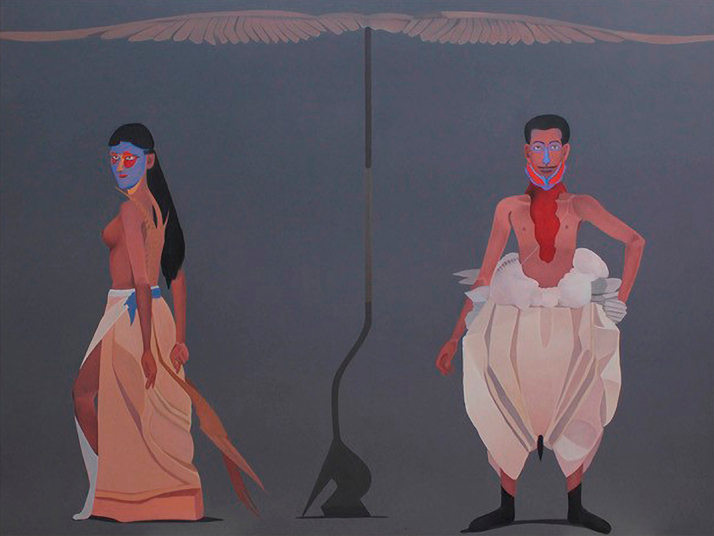-
From Current Issue
-
- Editor’s Letter Fire in the Heart
- Reviews I Gusti Ayu Kadek Murniasih
- Reviews 11th Seoul Mediacity Biennale: “One Escape at a Time”
- Dispatch Networked China
- One on One Monira Al Qadiri on Yukio Mishima
- Essays The rise of independent art spaces in pandemic-era Shanghai
- Features Tuan Andrew Nguyen
- Table of Contents
- Web Exclusives
- Archive
- Subscribe

R
E
V N
E
X
T
Installation view of SURENDRAN NAIR’s “Cuckoonebulopolis: (Flora and) Fauna” at Aicon Gallery, New York, 2017. Courtesy Aicon Gallery.
The comedic play, The Birds, by the ancient Greek playwright Aristophanes, revolves around the quest of birds to create their own kingdom in the sky between the warring gods in heaven and tempestuous mortals on earth. Loosely inspired by the liminality—the interfacing of the threshold between two planes—of such an imagined space, Indian artist Surendran Nair’s new body of work in “Cuckoonebulopolis: (Flora and) Fauna,” presented in the artist’s first solo exhibition at Aicon Gallery, explores notions of indeterminacy and ambiguity, while intending to push the viewer to consider new hypothetical realms of possibilities.
A continuation of the series “Cuckoonebulopolis,” which the artist began in 2000, “Cuckoonebulopolis: (Flora and) Fauna” is comprised of painted mythological portraits that filled the gallery. Often depicted with bird-like features: wings, beaks and plumes of feathers, the characters in Nair’s world seem to be mystical and otherworldly. In Wheatear (2016), a young man in a winged skirt and eye mask attached to a protruding beak-like nose and sleek, long crest stands on his toes like a ballet dancer. He appears to be empowered, possibly even ready to fly. Similarly, in Sarus Crane (2017), a crane’s head is attached to the crown of a young woman. Adorned in an Olympic blue feathered skirt that trails behind her, she stands as if she is supported by some celestial power.
No matter their bearing, the characters dressed in costumes with kabuki-style painted faces, who Nair refers to as “actors,” are notable for their calm meditative stance. From their expressions, it seems as if the performers hover on the threshold of a tranquil, almost spiritual space. Their pensive, almost disembodied performances as pelicans, flamingos and pheasants, referencing mythology and classical iconography, transport us to a world outside our existence. One experiences this sense of austere repose and otherworldliness from the countenance of Nair’s preliminary figurative drawings, which also feature in the exhibition. The stark, formal configuration of the male and female figures pitted against a bare gray background in his large-scale paintings, such as Pheasant and a Gobbler (2016–17), furthers this air of imminent transcendence.
While the characters in “Cuckoonebulopolis: (Flora and) Fauna” stand in preparation for ascension, Nair presents a different realm of engagement altogether in his series “Alibis of the Cognates” (2015), which consists of 12 digital prints, collaged from fragments of the artist’s previous works. Unlike his painted figures that are composed and static, there is certain joie de vivre and carefreeness in the spirit of these digital works. A sadhu with a beguiling smile appears to be in conversation with an upright, goat-headed snake, and we observe a naked genie that is part-clown, part-magician emerge mid-air above a kettle. In other works, Egyptian goddesses and flying beasts that can only exist within myths run abound.
The mash-up of illusive spaces and images allures viewers to engage in willing suspension of disbelief. Akin to the actors who draw us in, our association with the human figures in the digital series entices us into their surreal worlds and enables the production of our own variations. It is this encounter between the material and the immaterial that facilitates viewers to mediate an indeterminate world while maintaining a residual attachment to reality as it exits. During a conversation on the opening night of the exhibition in New York, Nair quite categorically stated that he is neither a utopian nor a surrealist. In fact, the world he investigates is one in which there is a constant push and pull between the real and the unreal, the concrete and the abstract.
For Nair, it is this very idea of negotiating a liminal territory between the palpable and the imaginary that is paramount to his practice. His vision paints two worlds—one in which we have an inkling of the notions of transcendence and spirituality, and the other that considers the limits of the human mind, as we search for new realities.
Surendran Nair’s “Cuckoonebulopolis: (Flora and) Fauna” is on view at Aicon Gallery, New York until August 5, 2017.
To read more of ArtAsiaPacific’s articles, visit our Digital Library.







